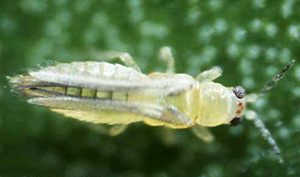Chilli Thrips

Thrips are small, winged insects with piercing-sucking mouthparts. They feed by piercing plant cells and sucking out the juices. The cell dies as a result, damaging the plant and making it vulnerable to infection.
While many species of thrips are native to Florida, chilli thrips are not. Scirtothrips dorsalis are invasive and cause significant damage in Florida and Texas. If you find chilli thrips in your landscape, please contact your county Extension office.
Biology
Chilli thrips are native to southern and eastern Asia. They were first identified in Florida around 1991. By 2005 an established population was found on roses in Palm Beach County.
Chilli thrips have a short life cycle that lasts about 18-20 days. They go through four life stages: egg, larvae, pupa, and adult. A female can lay around 60 eggs in her lifetime. Most prefer to deposit eggs into soft, young plant tissue. Eggs usually hatch in 2-8 days, depending on temperature. Larvae begin feeding immediately, going through two instars (development stages) over the next 8-10 days. The thrips then pupate and emerge as winged adults.
Identification

Chilli thrips feed on dozens of plants. Roses, citrus, plumbago, Indian hawthorn, and peppers are common hosts. Chilli thrips attack all above-ground growth, but prefer young leaves, buds, and fruits. Thrips damage a plant’s young leaves, but the effect on the plant varies.
Common symptoms of chilli thrips feeding include leaf bronzing and silvering, leaf curl, and shoot dieback. Heavy infestations occur during long hot and dry periods. The result is often extensive leaf curling and leaf loss. Infested plants decline over time and may experience total leaf loss.
You can check for thrips by shaking injured parts of the plants over a white piece of paper. Chilli thrips are smaller than flower thrips. At maturity they are about 0.04 inches long and are most easily seen with a hand lens. Adults have pale yellow bodies with dark fringed wings and dark spots down the back of the abdomen. They have wide heads with antennae.
Pest Management
Cultural, biological, and chemical controls can help you manage chilli thrips infestations before they get out of hand.
Cultural controls use everyday gardening techniques to keep pests at bay. An integrated pest management (IPM) plan that includes regular scouting can help you detect chilli thrips early. If you do identify this species, remove nearby host plants, such as weeds.
Attracting beneficial insects is a form of biological control. Minute pirate bugs, predatory mites, and big-eyed bugs all feed on chilli thrips. The best thing you can do for beneficial insects is to learn to recognize them. To protect beneficial insects, avoid chemical products that might kill them along with the target pest.
For help identifying and managing chilli thrips, please contact your county Extension office.
